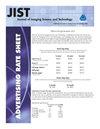Grey Balance in Cross Media Reproductions
IF 0.6
4区 计算机科学
Q4 IMAGING SCIENCE & PHOTOGRAPHIC TECHNOLOGY
Journal of Imaging Science and Technology
Pub Date : 2023-09-01
DOI:10.2352/j.imagingsci.technol.2023.67.5.050411
引用次数: 0
Abstract
Grey balance plays an important role in determining the device values needed to reproduce colours which appear achromatic throughout the tonal range. However, complete observer adaptation to the media white rarely occurs, and these designated device values can still appear non-neutral. This poses a problem for cross-media reproductions, where a mismatch in neutral colours is often the most noticeable difference between them. This paper presents two related experiments which investigate a means of gaining better visual agreement between reproductions which have different background colours or media whites. The first quantifies the degree of adjustment (the degree of media relative transform) needed to make an appearance match between grey patches on a white background and on background colours of various hues and colourfulness. It was found that the degree of adjustment was near-linearly related to the luminance of the patch itself, with lighter patches requiring greater adjustment towards the background colour. Neither the hue nor the chroma of the patch’s background had any significant effect on the underlying function. In the second experiment, this concept is applied to pictorial images on paper-coloured backgrounds. Three pixelwise rendering strategies were compared. In side-by-side viewing, the adaptive control of neutrals outperformed the media relative transform in all cases. Even for modest differences in paper colour (ΔEab of 3), images with significant neutral content benefited from the adaptive approach.跨媒体复制中的灰平衡
灰平衡在确定再现在整个色调范围内出现无色差的颜色所需的设备值方面起着重要作用。然而,完全适应媒体白色的观察者很少发生,这些指定的设备值仍然可以表现为非中性。这给跨媒体复制带来了一个问题,其中中性色的不匹配通常是它们之间最明显的差异。本文提出了两个相关的实验,研究了在具有不同背景颜色或介质白色的复制品之间获得更好的视觉一致性的方法。第一个量化了在白色背景上的灰色斑块与各种色调和色彩的背景颜色之间进行外观匹配所需的调整程度(媒体相对变换的程度)。结果发现,调整的程度与贴片本身的亮度近似线性相关,较亮的贴片需要对背景颜色进行较大的调整。色相和背景色度对底层功能都没有显著影响。在第二个实验中,这个概念被应用于纸张彩色背景上的图像。比较了三种像素渲染策略。在并排观察中,中立点的自适应控制在所有情况下都优于介质相对变换。即使纸张颜色差异不大(ΔEab = 3),具有显著中性内容的图像也能从自适应方法中受益。
本文章由计算机程序翻译,如有差异,请以英文原文为准。
求助全文
约1分钟内获得全文
求助全文
来源期刊

Journal of Imaging Science and Technology
工程技术-成像科学与照相技术
CiteScore
2.00
自引率
10.00%
发文量
45
审稿时长
>12 weeks
期刊介绍:
Typical issues include research papers and/or comprehensive reviews from a variety of topical areas. In the spirit of fostering constructive scientific dialog, the Journal accepts Letters to the Editor commenting on previously published articles. Periodically the Journal features a Special Section containing a group of related— usually invited—papers introduced by a Guest Editor. Imaging research topics that have coverage in JIST include:
Digital fabrication and biofabrication;
Digital printing technologies;
3D imaging: capture, display, and print;
Augmented and virtual reality systems;
Mobile imaging;
Computational and digital photography;
Machine vision and learning;
Data visualization and analysis;
Image and video quality evaluation;
Color image science;
Image archiving, permanence, and security;
Imaging applications including astronomy, medicine, sports, and autonomous vehicles.
 求助内容:
求助内容: 应助结果提醒方式:
应助结果提醒方式:


